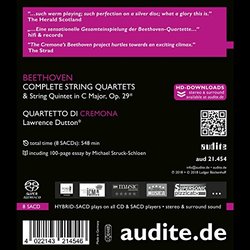| All Artists: Quartetto di Cremona Title: Beethoven: Complete String Quartets Members Wishing: 0 Total Copies: 0 Label: Audite Release Date: 7/6/2018 Album Type: Hybrid SACD - DSD Genre: Classical Style: Chamber Music Number of Discs: 8 SwapaCD Credits: 8 |
Search - Quartetto di Cremona :: Beethoven: Complete String Quartets
 | Quartetto di Cremona Beethoven: Complete String Quartets Genre: Classical The celebrated recording of the Complete Beethoven String Quartets with the Quartetto di Cremona is now once again available. This edition makes available all the composers string quartets, alongside his String Quintet No.... more » |
Larger Image |
CD Details
Synopsis
Product Description
The celebrated recording of the Complete Beethoven String Quartets with the Quartetto di Cremona is now once again available. This edition makes available all the composers string quartets, alongside his String Quintet No. 29 (the only original work by Beethoven with this scoring), in the highest quality. such warm playing; such perfection what a glory this is. (The Herald) The Cremonas Beethoven project hurtles towards an exciting climax. (The Strad) During the past eighteen years the Quartetto di Cremona has matured into a string quartet of international renown and has acquired an excellent national and international reputation. Having for many years performed at the great international halls, it is often considered as the successor to the famous Quartetto Italiano. The musical style of the Quartetto di Cremona is marked by a fruitful tension between Italian and German-Austrian influences. Following their academic studies the players continued their training with Piero Farulli of the Quartetto Italiano. He strongly favored intuitive playing and a fervent, emotional, romantic, and Italian approach to music. Afterwards the musicians pursued their studies with Hatto Beyerle of the Alban Berg Quartet. He represented a clear, classical German-Austrian style. Both teachers significantly influenced the quartet, and the players naturally combine both poles, mixing enthusiasm with a sense of musical architecture.
